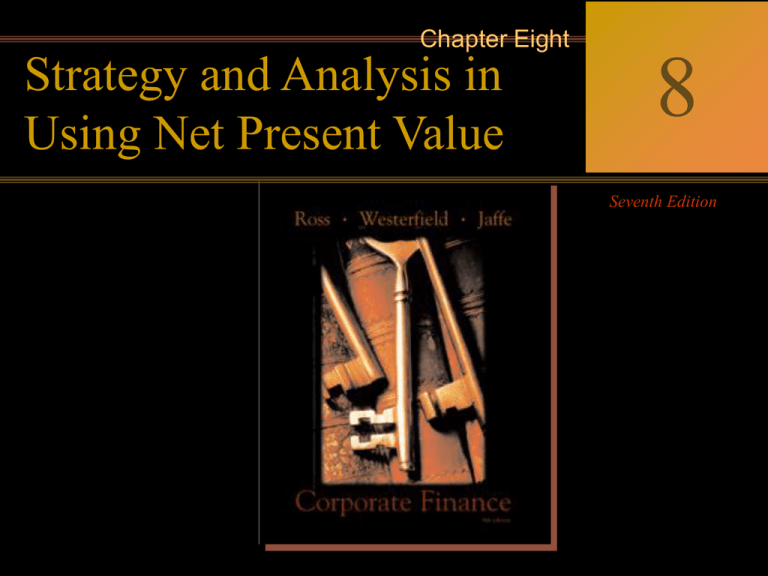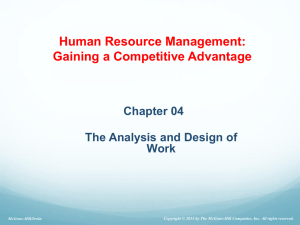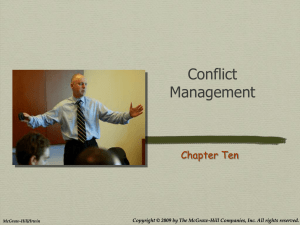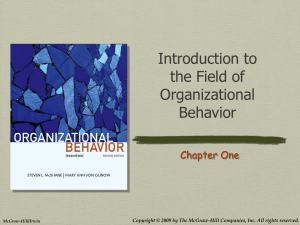
8-0
Chapter Eight
Strategy and Analysis
in
Corporate Finance
Ross Westerfield Jaffe
Using Net Present Value
8
Seventh Edition
Seventh Edition
McGraw-Hill/Irwin
Copyright © 2004 by The McGraw-Hill Companies, Inc. All rights reserved.
8-1
Chapter Outline
8.1 Decision Trees
8.4 Options
McGraw-Hill/Irwin
Copyright © 2004 by The McGraw-Hill Companies, Inc. All rights reserved.
8-2
Stewart Pharmaceuticals
• The Stewart Pharmaceuticals Corporation is considering
investing in developing a drug that cures the common cold.
• A corporate planning group, including representatives from
production, marketing, and engineering, has recommended
that the firm go ahead with the test and development phase.
• This preliminary phase will last one year and cost $1 billion.
Furthermore, the group believes that there is a 60% chance
that tests will prove successful.
• If the initial tests are successful, Stewart Pharmaceuticals can
go ahead with full-scale production. This investment phase
will cost $1.6 billion. Production will occur over the next 4
years.
McGraw-Hill/Irwin
Copyright © 2004 by The McGraw-Hill Companies, Inc. All rights reserved.
8-3
Stewart Pharmaceuticals NPV of Full-Scale
Production following Successful Test
Investment
Year 1
Years 2-5
Revenues
$7,000
Variable Costs
(3,000)
Fixed Costs
(1,800)
Depreciation
(400)
Pretax profit
$1,800
Tax (34%)
(612)
Net Profit
$1,188
Cash Flow
-$1,600
$1,588
4
NPV $1,600
t 1
$1,588
$3,433.75
t
(1.10)
Note that the NPV is calculated as of date 1, the date at which the investment of $1,600 million is
made. Later we bring this number back to date 0.
McGraw-Hill/Irwin
Copyright © 2004 by The McGraw-Hill Companies, Inc. All rights reserved.
8-4
Stewart Pharmaceuticals NPV of Full-Scale
Production following Unsuccessful Test
Investment
Year 1
Years 2-5
Revenues
$4,050
Variable Costs
(1,735)
Fixed Costs
(1,800)
Depreciation
(400)
Pretax profit
$115
Tax (34%)
(39.10)
Net Profit
$75.90
Cash Flow
-$1,600
$475
4
$475.90
$91.461
t
t 1 (1.10)
NPV $1,600
Note that the NPV is calculated as of date 1, the date at which the investment of $1,600 million is
made. Later we bring this number back to date 0.
McGraw-Hill/Irwin
Copyright © 2004 by The McGraw-Hill Companies, Inc. All rights reserved.
8-5
Decision Tree for Stewart Pharmaceutical
The firm has two decisions to make:
To test or not to test.
To invest or not to invest.
Success
Test
Invest
NPV = $3.4 b
Do not
invest
NPV = $0
Failure
Do not
test
McGraw-Hill/Irwin
NPV $0
Invest
NPV = –$91.46 m
Copyright © 2004 by The McGraw-Hill Companies, Inc. All rights reserved.
8-6
Stewart Pharmaceutical: Decision to Test
• Let’s move back to the first stage, where the decision boils
down to the simple question: should we invest?
• The expected payoff evaluated at date 1 is:
Payoff
Payoff
Prob.
Prob.
payoff
sucess given success failure given failure
Expected
Expected
.60 $3,433.75 .40 $0 $2,060.25
payoff
• The NPV evaluated at date 0 is:
NPV $1,000
$2,060.25
$872.95
1.10
So we should test.
McGraw-Hill/Irwin
Copyright © 2004 by The McGraw-Hill Companies, Inc. All rights reserved.
8-7
8.4 Options
• One of the fundamental insights of modern finance
theory is that options have value.
• The phrase “We are out of options” is surely a sign
of trouble.
• Because corporations make decisions in a dynamic
environment, they have options that should be
considered in project valuation.
McGraw-Hill/Irwin
Copyright © 2004 by The McGraw-Hill Companies, Inc. All rights reserved.
8-8
Options
• The Option to Expand
– Has value if demand turns out to be higher than
expected.
• The Option to Abandon
– Has value if demand turns out to be lower than
expected.
• The Option to Delay
– Has value if the underlying variables are
changing with a favorable trend.
McGraw-Hill/Irwin
Copyright © 2004 by The McGraw-Hill Companies, Inc. All rights reserved.
8-9
The Option to Expand
• Imagine a start-up firm, Campusteria, Inc. which
plans to open private (for-profit) dining clubs on
college campuses.
• The test market will be your campus, and if the
concept proves successful, expansion will follow
nationwide.
• Nationwide expansion, if it occurs, will occur in
year four.
• The start-up cost of the test dining club is only
$30,000 (this covers leaseholder improvements and
other expenses for a vacant restaurant near campus).
McGraw-Hill/Irwin
Copyright © 2004 by The McGraw-Hill Companies, Inc. All rights reserved.
8-10
Campusteria pro forma Income Statement
Investment
Year 0
Revenues
Years 1-4
$60,000
Variable Costs
($42,000)
Fixed Costs
($18,000)
Depreciation
($7,500)
Pretax profit
($7,500)
Tax shield 34%
$2,550
–$4,950
Net Profit
Cash Flow
–$30,000
4
$2,550
$2,550
NPV $30,000
$21,916.84
t
t 1 (1.10)
McGraw-Hill/Irwin
We plan to sell 25 meal
plans at $200 per
month with a 12-month
contract.
Variable costs are
projected to be
$3,500 per month.
Fixed costs (the lease
payment) are
projected to be
$1,500 per month.
We can depreciate
our capitalized
leaseholder
improvements.
Copyright © 2004 by The McGraw-Hill Companies, Inc. All rights reserved.
8-11
The Option to Expand: Valuing a Start-Up
• Note that while the Campusteria test site has a
negative NPV, we are close to our break-even level
of sales.
• If we expand, we project opening 20 Campusterias
in year four.
• The value of the project is in the option to expand.
• If we hit it big, we will be in a position to score
large.
• We won’t know if we don’t try.
McGraw-Hill/Irwin
Copyright © 2004 by The McGraw-Hill Companies, Inc. All rights reserved.
8-12
Discounted Cash Flows and Options
• We can calculate the market value of a project as the
sum of the NPV of the project without options and
the value of the managerial options implicit in the
project.
M = NPV + Opt
A good example would be comparing the
desirability of a specialized machine versus a more
versatile machine. If they both cost about the same
and last the same amount of time the more
versatile machine is more valuable because it
comes with options.
McGraw-Hill/Irwin
Copyright © 2004 by The McGraw-Hill Companies, Inc. All rights reserved.
8-13
The Option to Abandon: Example
• Suppose that we are drilling an oil well. The drilling
rig costs $300 today and in one year the well is
either a success or a failure.
• The outcomes are equally likely. The discount rate
is 10%.
• The PV of the successful payoff at time one is $575.
• The PV of the unsuccessful payoff at time one is $0.
McGraw-Hill/Irwin
Copyright © 2004 by The McGraw-Hill Companies, Inc. All rights reserved.
8-14
The Option to Abandon: Example
Traditional NPV analysis would indicate rejection of the project.
Expected = Prob. × Successful + Prob. × Failure
Payoff
Success Payoff
Failure Payoff
Expected
= (0.50×$575) + (0.50×$0) = $287.50
Payoff
NPV = –$300 +
McGraw-Hill/Irwin
$287.50
1.10
= –$38.64
Copyright © 2004 by The McGraw-Hill Companies, Inc. All rights reserved.
8-15
The Option to Abandon: Example
Traditional NPV analysis overlooks the option to abandon.
Success: PV = $575
Sit on rig; stare
at empty hole:
PV = $0.
Drill
$300
Failure
Do not
drill
NPV $0
Sell the rig;
salvage value
= $250
The firm has two decisions to make: drill or not, abandon or stay.
McGraw-Hill/Irwin
Copyright © 2004 by The McGraw-Hill Companies, Inc. All rights reserved.
8-16
The Option to Abandon: Example
• When we include the value of the option to abandon, the
drilling project should proceed:
Expected = Prob. × Successful + Prob. × Failure
Payoff
Success Payoff
Failure Payoff
Expected
= (0.50×$575) + (0.50×$250) = $412.50
Payoff
NPV = –$300 +
McGraw-Hill/Irwin
$412.50
1.10
= $75.00
Copyright © 2004 by The McGraw-Hill Companies, Inc. All rights reserved.
8-17
Valuation of the Option to Abandon
• Recall that we can calculate the market value of a
project as the sum of the NPV of the project without
options and the value of the managerial options
implicit in the project.
M = NPV + Opt
$75.00 = –$38.61 + Opt
$75.00 + $38.61 = Opt
Opt = $113.64
McGraw-Hill/Irwin
Copyright © 2004 by The McGraw-Hill Companies, Inc. All rights reserved.
8-18
The Option to Delay: Example
Year
0
1
2
3
44
Cost
$ 20,000
$ 18,000
$ 17,100
$ 16,929
16,760
$$ 16,760
PV
$ 25,000
$ 25,000
$ 25,000
$ 25,000
25,000
$$ 25,000
NPV tt
$ 5,000
$ 7,000
$ 7,900
$ 8,071
8,240
$$8,240
NPV 0
$ 5,000
$ 6,364
$7,900
$ 6,529 $6,529
(1.10) 2
$ 6,064
$ 5,628
• Consider the above project, which can be undertaken in any
of the next 4 years. The discount rate is 10 percent. The
present value of the benefits at the time the project is
launched remain constant at $25,000, but since costs are
declining the NPV at the time of launch steadily rises.
• The best time to launch the project is in year 2—this
schedule yields the highest NPV when judged today.
McGraw-Hill/Irwin
Copyright © 2004 by The McGraw-Hill Companies, Inc. All rights reserved.









